Sustainable and Responsible Tourism Management Report: Analysis
VerifiedAdded on 2023/01/11
|17
|4916
|72
Report
AI Summary
This report provides a comprehensive analysis of sustainable and responsible tourism management. It begins by tracing the evolution of sustainable tourism, highlighting key milestones and the shift towards a more holistic approach. The report then identifies the roles, missions, and functions of leading global organizations such as UNWTO and WTTC in promoting responsible and sustainable tourism. It analyzes the concept of responsible and sustainable tourism in accordance with legal global organizations and explores principles and purpose of tourism development and planning to minimize adverse effects. The report evaluates the tourism development process, identifying linked problems and challenges, and examines different approaches to achieve sustainable objectives. It also assesses the social, economic, environmental, and cultural impacts of tourism activities, applying principles of sustainability to a chosen destination (Dutch QualityCoast, Delta). The report further evaluates how sustainability is developed and managed in a range of tourist destinations worldwide, providing a critical evaluation of success and failure, and concludes with recommendations for improving sustainable development and management practices.
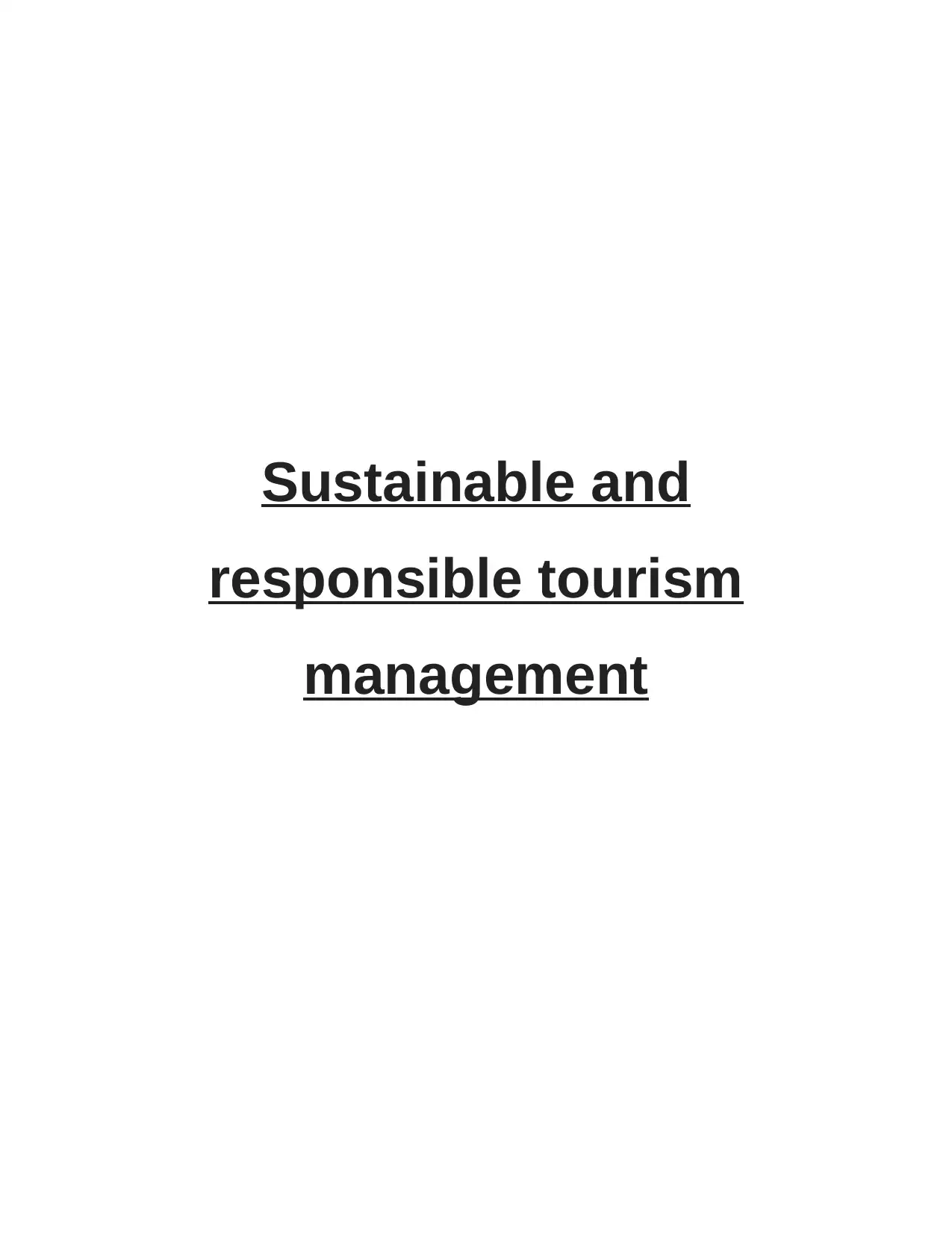
Sustainable and
responsible tourism
management
responsible tourism
management
Paraphrase This Document
Need a fresh take? Get an instant paraphrase of this document with our AI Paraphraser
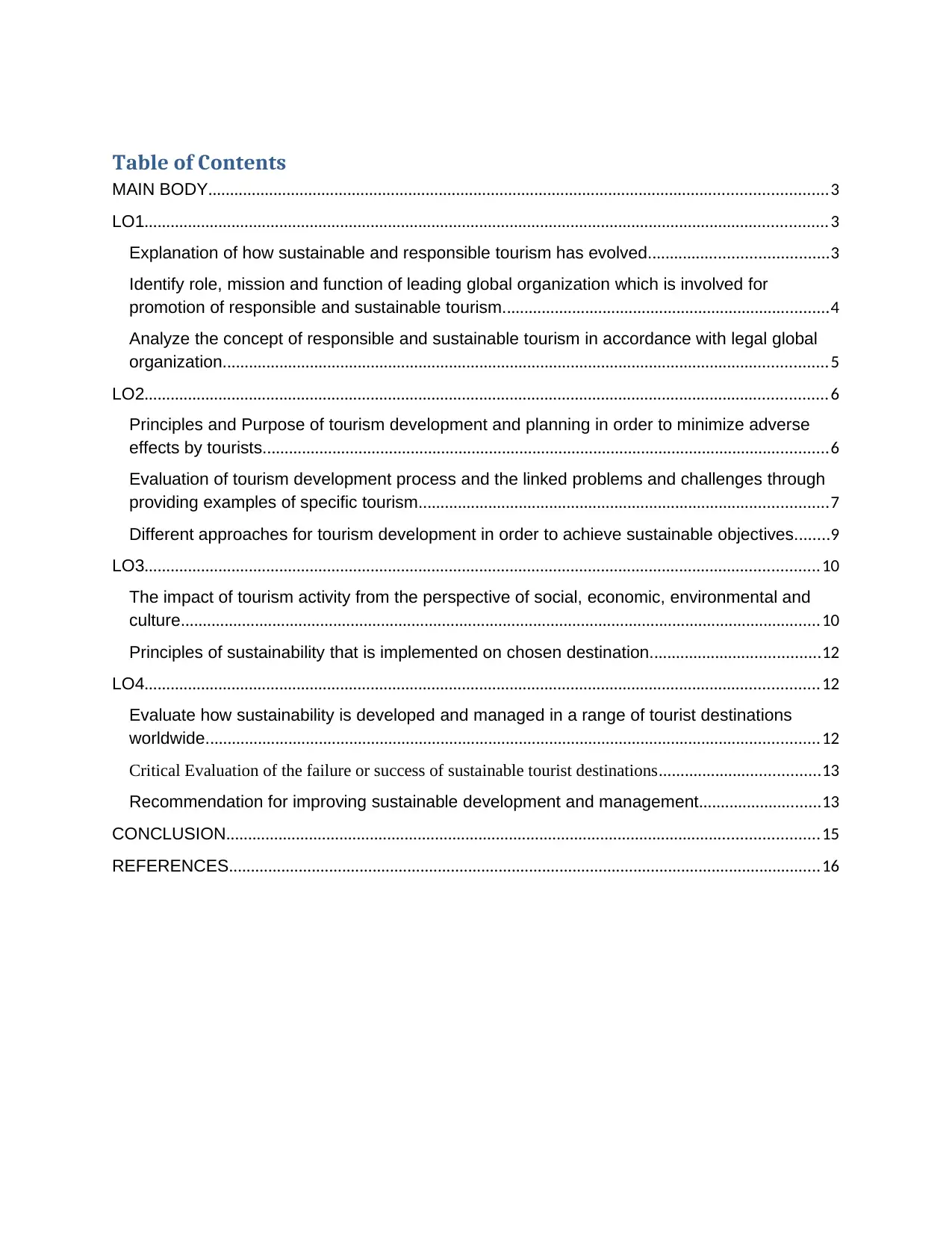
Table of Contents
MAIN BODY..............................................................................................................................................3
LO1.............................................................................................................................................................3
Explanation of how sustainable and responsible tourism has evolved.........................................3
Identify role, mission and function of leading global organization which is involved for
promotion of responsible and sustainable tourism...........................................................................4
Analyze the concept of responsible and sustainable tourism in accordance with legal global
organization...........................................................................................................................................5
LO2.............................................................................................................................................................6
Principles and Purpose of tourism development and planning in order to minimize adverse
effects by tourists..................................................................................................................................6
Evaluation of tourism development process and the linked problems and challenges through
providing examples of specific tourism..............................................................................................7
Different approaches for tourism development in order to achieve sustainable objectives........9
LO3...........................................................................................................................................................10
The impact of tourism activity from the perspective of social, economic, environmental and
culture...................................................................................................................................................10
Principles of sustainability that is implemented on chosen destination.......................................12
LO4...........................................................................................................................................................12
Evaluate how sustainability is developed and managed in a range of tourist destinations
worldwide.............................................................................................................................................12
Critical Evaluation of the failure or success of sustainable tourist destinations.....................................13
Recommendation for improving sustainable development and management............................13
CONCLUSION........................................................................................................................................15
REFERENCES........................................................................................................................................16
MAIN BODY..............................................................................................................................................3
LO1.............................................................................................................................................................3
Explanation of how sustainable and responsible tourism has evolved.........................................3
Identify role, mission and function of leading global organization which is involved for
promotion of responsible and sustainable tourism...........................................................................4
Analyze the concept of responsible and sustainable tourism in accordance with legal global
organization...........................................................................................................................................5
LO2.............................................................................................................................................................6
Principles and Purpose of tourism development and planning in order to minimize adverse
effects by tourists..................................................................................................................................6
Evaluation of tourism development process and the linked problems and challenges through
providing examples of specific tourism..............................................................................................7
Different approaches for tourism development in order to achieve sustainable objectives........9
LO3...........................................................................................................................................................10
The impact of tourism activity from the perspective of social, economic, environmental and
culture...................................................................................................................................................10
Principles of sustainability that is implemented on chosen destination.......................................12
LO4...........................................................................................................................................................12
Evaluate how sustainability is developed and managed in a range of tourist destinations
worldwide.............................................................................................................................................12
Critical Evaluation of the failure or success of sustainable tourist destinations.....................................13
Recommendation for improving sustainable development and management............................13
CONCLUSION........................................................................................................................................15
REFERENCES........................................................................................................................................16
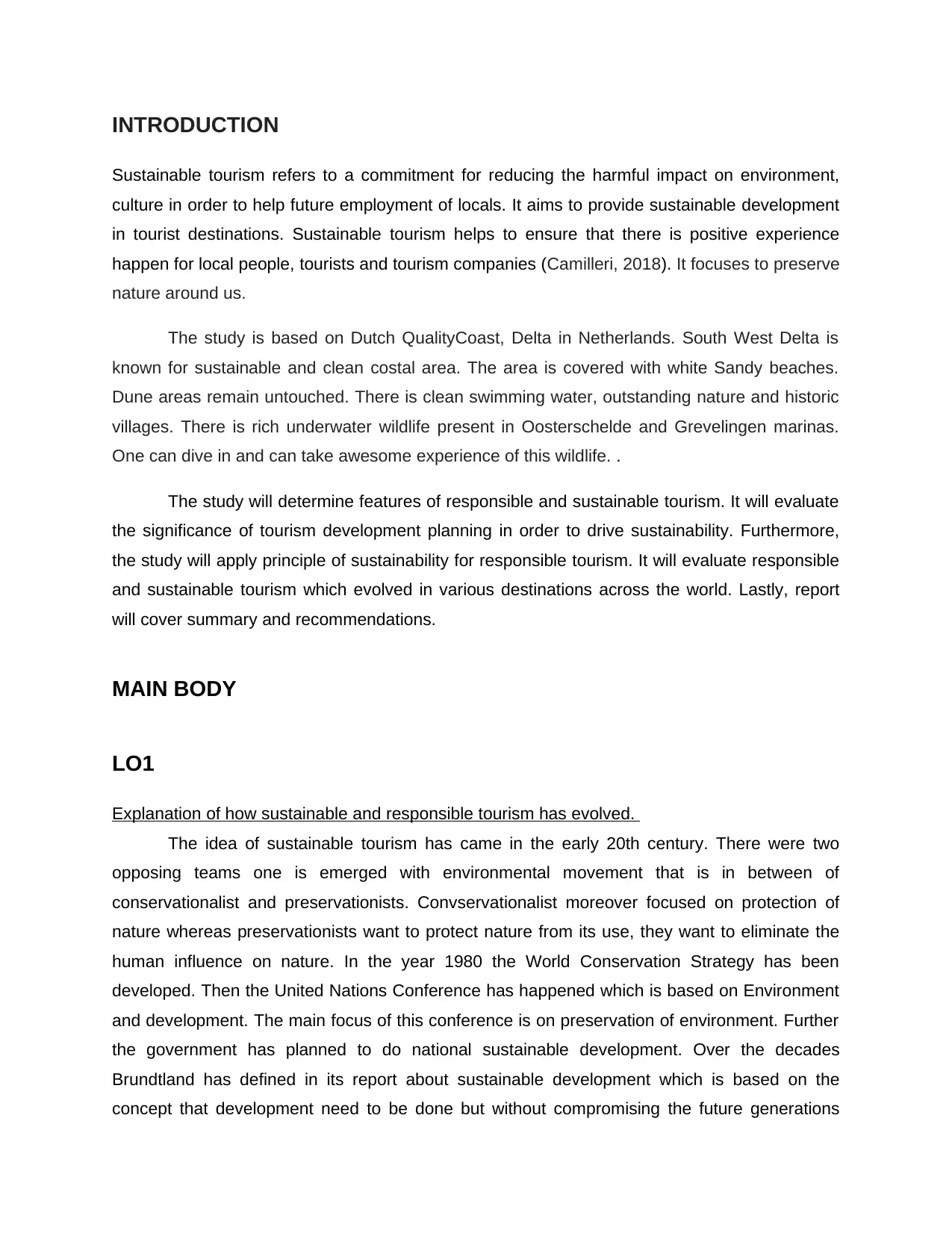
INTRODUCTION
Sustainable tourism refers to a commitment for reducing the harmful impact on environment,
culture in order to help future employment of locals. It aims to provide sustainable development
in tourist destinations. Sustainable tourism helps to ensure that there is positive experience
happen for local people, tourists and tourism companies (Camilleri, 2018). It focuses to preserve
nature around us.
The study is based on Dutch QualityCoast, Delta in Netherlands. South West Delta is
known for sustainable and clean costal area. The area is covered with white Sandy beaches.
Dune areas remain untouched. There is clean swimming water, outstanding nature and historic
villages. There is rich underwater wildlife present in Oosterschelde and Grevelingen marinas.
One can dive in and can take awesome experience of this wildlife. .
The study will determine features of responsible and sustainable tourism. It will evaluate
the significance of tourism development planning in order to drive sustainability. Furthermore,
the study will apply principle of sustainability for responsible tourism. It will evaluate responsible
and sustainable tourism which evolved in various destinations across the world. Lastly, report
will cover summary and recommendations.
MAIN BODY
LO1
Explanation of how sustainable and responsible tourism has evolved.
The idea of sustainable tourism has came in the early 20th century. There were two
opposing teams one is emerged with environmental movement that is in between of
conservationalist and preservationists. Convservationalist moreover focused on protection of
nature whereas preservationists want to protect nature from its use, they want to eliminate the
human influence on nature. In the year 1980 the World Conservation Strategy has been
developed. Then the United Nations Conference has happened which is based on Environment
and development. The main focus of this conference is on preservation of environment. Further
the government has planned to do national sustainable development. Over the decades
Brundtland has defined in its report about sustainable development which is based on the
concept that development need to be done but without compromising the future generations
Sustainable tourism refers to a commitment for reducing the harmful impact on environment,
culture in order to help future employment of locals. It aims to provide sustainable development
in tourist destinations. Sustainable tourism helps to ensure that there is positive experience
happen for local people, tourists and tourism companies (Camilleri, 2018). It focuses to preserve
nature around us.
The study is based on Dutch QualityCoast, Delta in Netherlands. South West Delta is
known for sustainable and clean costal area. The area is covered with white Sandy beaches.
Dune areas remain untouched. There is clean swimming water, outstanding nature and historic
villages. There is rich underwater wildlife present in Oosterschelde and Grevelingen marinas.
One can dive in and can take awesome experience of this wildlife. .
The study will determine features of responsible and sustainable tourism. It will evaluate
the significance of tourism development planning in order to drive sustainability. Furthermore,
the study will apply principle of sustainability for responsible tourism. It will evaluate responsible
and sustainable tourism which evolved in various destinations across the world. Lastly, report
will cover summary and recommendations.
MAIN BODY
LO1
Explanation of how sustainable and responsible tourism has evolved.
The idea of sustainable tourism has came in the early 20th century. There were two
opposing teams one is emerged with environmental movement that is in between of
conservationalist and preservationists. Convservationalist moreover focused on protection of
nature whereas preservationists want to protect nature from its use, they want to eliminate the
human influence on nature. In the year 1980 the World Conservation Strategy has been
developed. Then the United Nations Conference has happened which is based on Environment
and development. The main focus of this conference is on preservation of environment. Further
the government has planned to do national sustainable development. Over the decades
Brundtland has defined in its report about sustainable development which is based on the
concept that development need to be done but without compromising the future generations
⊘ This is a preview!⊘
Do you want full access?
Subscribe today to unlock all pages.

Trusted by 1+ million students worldwide
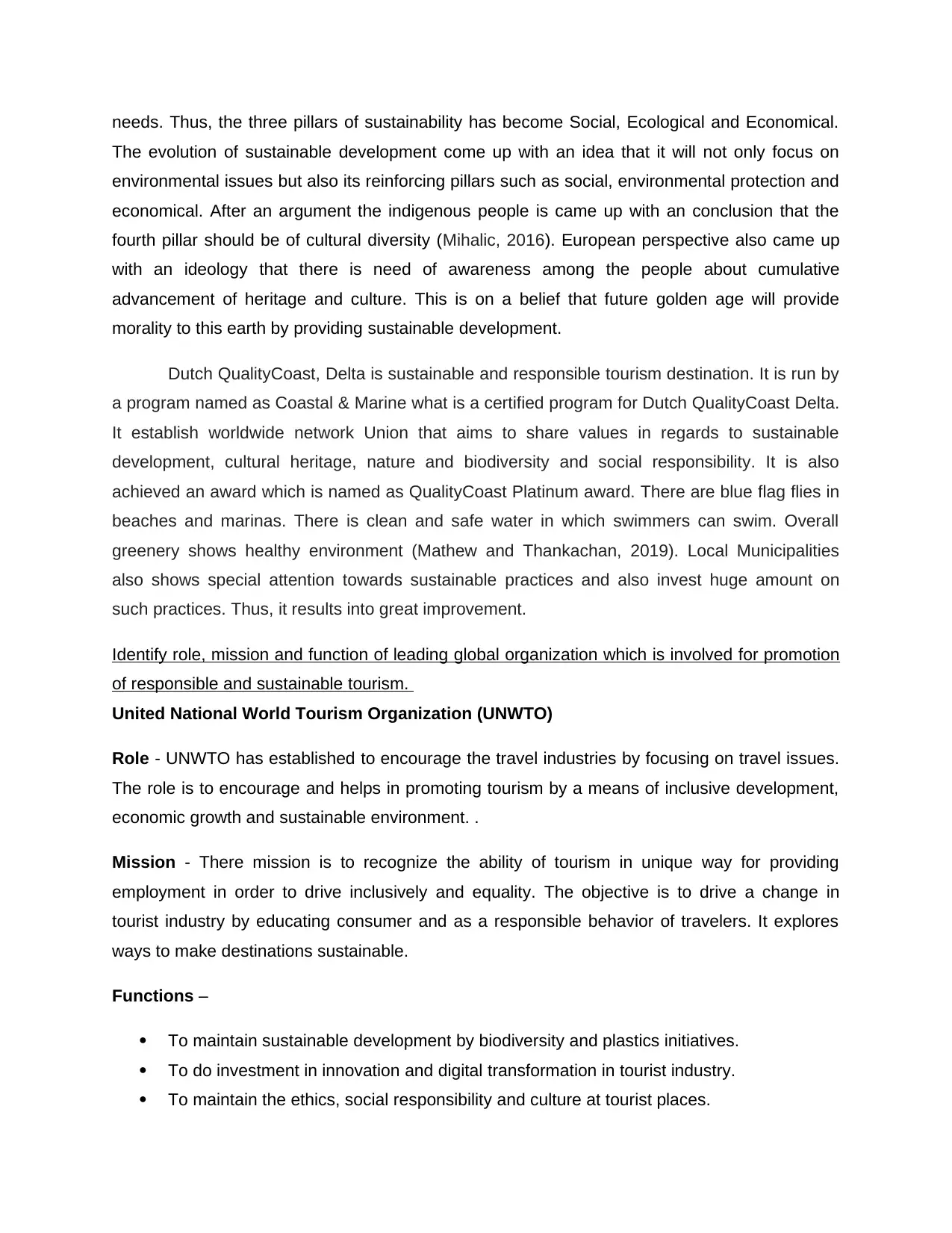
needs. Thus, the three pillars of sustainability has become Social, Ecological and Economical.
The evolution of sustainable development come up with an idea that it will not only focus on
environmental issues but also its reinforcing pillars such as social, environmental protection and
economical. After an argument the indigenous people is came up with an conclusion that the
fourth pillar should be of cultural diversity (Mihalic, 2016). European perspective also came up
with an ideology that there is need of awareness among the people about cumulative
advancement of heritage and culture. This is on a belief that future golden age will provide
morality to this earth by providing sustainable development.
Dutch QualityCoast, Delta is sustainable and responsible tourism destination. It is run by
a program named as Coastal & Marine what is a certified program for Dutch QualityCoast Delta.
It establish worldwide network Union that aims to share values in regards to sustainable
development, cultural heritage, nature and biodiversity and social responsibility. It is also
achieved an award which is named as QualityCoast Platinum award. There are blue flag flies in
beaches and marinas. There is clean and safe water in which swimmers can swim. Overall
greenery shows healthy environment (Mathew and Thankachan, 2019). Local Municipalities
also shows special attention towards sustainable practices and also invest huge amount on
such practices. Thus, it results into great improvement.
Identify role, mission and function of leading global organization which is involved for promotion
of responsible and sustainable tourism.
United National World Tourism Organization (UNWTO)
Role - UNWTO has established to encourage the travel industries by focusing on travel issues.
The role is to encourage and helps in promoting tourism by a means of inclusive development,
economic growth and sustainable environment. .
Mission - There mission is to recognize the ability of tourism in unique way for providing
employment in order to drive inclusively and equality. The objective is to drive a change in
tourist industry by educating consumer and as a responsible behavior of travelers. It explores
ways to make destinations sustainable.
Functions –
To maintain sustainable development by biodiversity and plastics initiatives.
To do investment in innovation and digital transformation in tourist industry.
To maintain the ethics, social responsibility and culture at tourist places.
The evolution of sustainable development come up with an idea that it will not only focus on
environmental issues but also its reinforcing pillars such as social, environmental protection and
economical. After an argument the indigenous people is came up with an conclusion that the
fourth pillar should be of cultural diversity (Mihalic, 2016). European perspective also came up
with an ideology that there is need of awareness among the people about cumulative
advancement of heritage and culture. This is on a belief that future golden age will provide
morality to this earth by providing sustainable development.
Dutch QualityCoast, Delta is sustainable and responsible tourism destination. It is run by
a program named as Coastal & Marine what is a certified program for Dutch QualityCoast Delta.
It establish worldwide network Union that aims to share values in regards to sustainable
development, cultural heritage, nature and biodiversity and social responsibility. It is also
achieved an award which is named as QualityCoast Platinum award. There are blue flag flies in
beaches and marinas. There is clean and safe water in which swimmers can swim. Overall
greenery shows healthy environment (Mathew and Thankachan, 2019). Local Municipalities
also shows special attention towards sustainable practices and also invest huge amount on
such practices. Thus, it results into great improvement.
Identify role, mission and function of leading global organization which is involved for promotion
of responsible and sustainable tourism.
United National World Tourism Organization (UNWTO)
Role - UNWTO has established to encourage the travel industries by focusing on travel issues.
The role is to encourage and helps in promoting tourism by a means of inclusive development,
economic growth and sustainable environment. .
Mission - There mission is to recognize the ability of tourism in unique way for providing
employment in order to drive inclusively and equality. The objective is to drive a change in
tourist industry by educating consumer and as a responsible behavior of travelers. It explores
ways to make destinations sustainable.
Functions –
To maintain sustainable development by biodiversity and plastics initiatives.
To do investment in innovation and digital transformation in tourist industry.
To maintain the ethics, social responsibility and culture at tourist places.
Paraphrase This Document
Need a fresh take? Get an instant paraphrase of this document with our AI Paraphraser
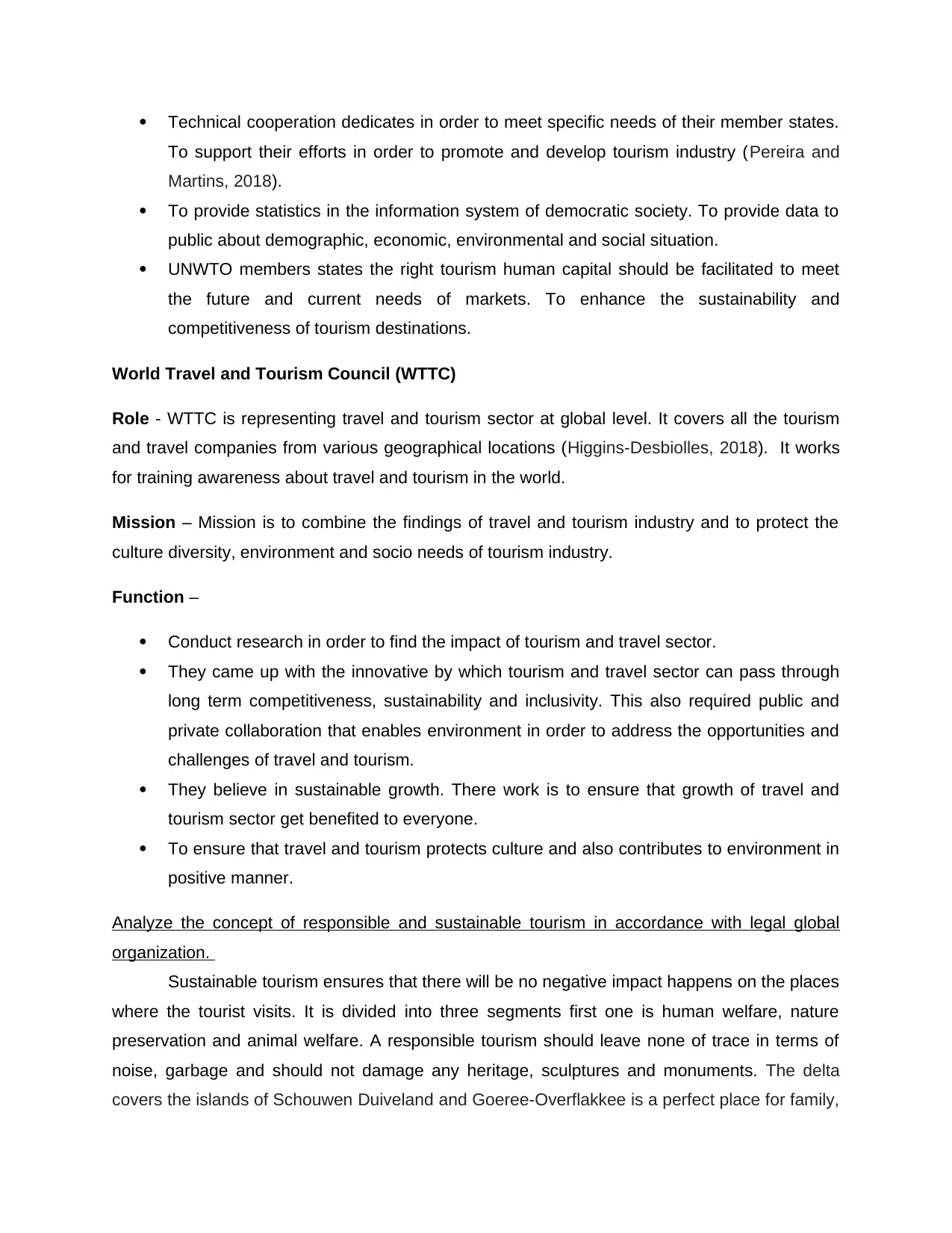
Technical cooperation dedicates in order to meet specific needs of their member states.
To support their efforts in order to promote and develop tourism industry (Pereira and
Martins, 2018).
To provide statistics in the information system of democratic society. To provide data to
public about demographic, economic, environmental and social situation.
UNWTO members states the right tourism human capital should be facilitated to meet
the future and current needs of markets. To enhance the sustainability and
competitiveness of tourism destinations.
World Travel and Tourism Council (WTTC)
Role - WTTC is representing travel and tourism sector at global level. It covers all the tourism
and travel companies from various geographical locations (Higgins-Desbiolles, 2018). It works
for training awareness about travel and tourism in the world.
Mission – Mission is to combine the findings of travel and tourism industry and to protect the
culture diversity, environment and socio needs of tourism industry.
Function –
Conduct research in order to find the impact of tourism and travel sector.
They came up with the innovative by which tourism and travel sector can pass through
long term competitiveness, sustainability and inclusivity. This also required public and
private collaboration that enables environment in order to address the opportunities and
challenges of travel and tourism.
They believe in sustainable growth. There work is to ensure that growth of travel and
tourism sector get benefited to everyone.
To ensure that travel and tourism protects culture and also contributes to environment in
positive manner.
Analyze the concept of responsible and sustainable tourism in accordance with legal global
organization.
Sustainable tourism ensures that there will be no negative impact happens on the places
where the tourist visits. It is divided into three segments first one is human welfare, nature
preservation and animal welfare. A responsible tourism should leave none of trace in terms of
noise, garbage and should not damage any heritage, sculptures and monuments. The delta
covers the islands of Schouwen Duiveland and Goeree-Overflakkee is a perfect place for family,
To support their efforts in order to promote and develop tourism industry (Pereira and
Martins, 2018).
To provide statistics in the information system of democratic society. To provide data to
public about demographic, economic, environmental and social situation.
UNWTO members states the right tourism human capital should be facilitated to meet
the future and current needs of markets. To enhance the sustainability and
competitiveness of tourism destinations.
World Travel and Tourism Council (WTTC)
Role - WTTC is representing travel and tourism sector at global level. It covers all the tourism
and travel companies from various geographical locations (Higgins-Desbiolles, 2018). It works
for training awareness about travel and tourism in the world.
Mission – Mission is to combine the findings of travel and tourism industry and to protect the
culture diversity, environment and socio needs of tourism industry.
Function –
Conduct research in order to find the impact of tourism and travel sector.
They came up with the innovative by which tourism and travel sector can pass through
long term competitiveness, sustainability and inclusivity. This also required public and
private collaboration that enables environment in order to address the opportunities and
challenges of travel and tourism.
They believe in sustainable growth. There work is to ensure that growth of travel and
tourism sector get benefited to everyone.
To ensure that travel and tourism protects culture and also contributes to environment in
positive manner.
Analyze the concept of responsible and sustainable tourism in accordance with legal global
organization.
Sustainable tourism ensures that there will be no negative impact happens on the places
where the tourist visits. It is divided into three segments first one is human welfare, nature
preservation and animal welfare. A responsible tourism should leave none of trace in terms of
noise, garbage and should not damage any heritage, sculptures and monuments. The delta
covers the islands of Schouwen Duiveland and Goeree-Overflakkee is a perfect place for family,
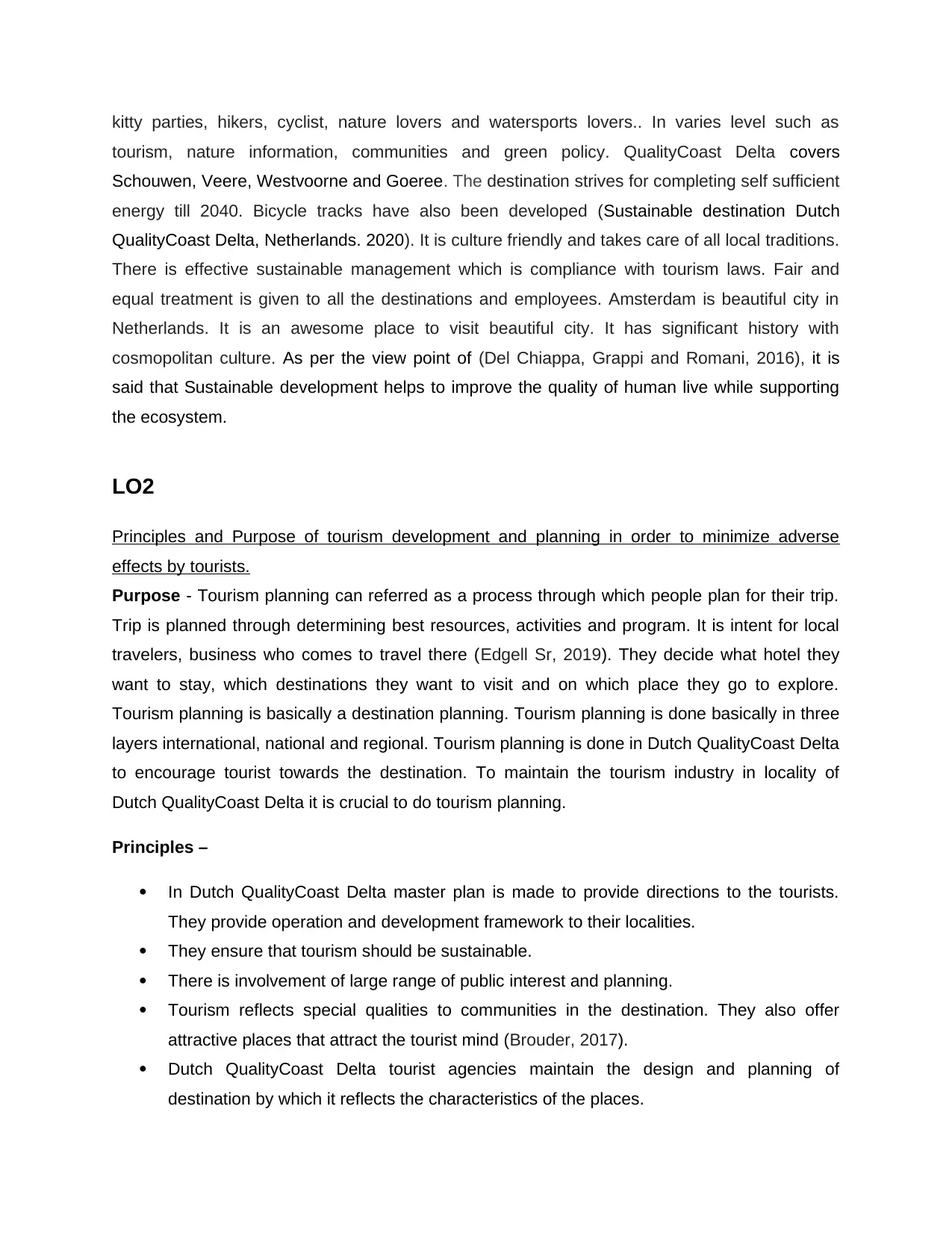
kitty parties, hikers, cyclist, nature lovers and watersports lovers.. In varies level such as
tourism, nature information, communities and green policy. QualityCoast Delta covers
Schouwen, Veere, Westvoorne and Goeree. The destination strives for completing self sufficient
energy till 2040. Bicycle tracks have also been developed (Sustainable destination Dutch
QualityCoast Delta, Netherlands. 2020). It is culture friendly and takes care of all local traditions.
There is effective sustainable management which is compliance with tourism laws. Fair and
equal treatment is given to all the destinations and employees. Amsterdam is beautiful city in
Netherlands. It is an awesome place to visit beautiful city. It has significant history with
cosmopolitan culture. As per the view point of (Del Chiappa, Grappi and Romani, 2016), it is
said that Sustainable development helps to improve the quality of human live while supporting
the ecosystem.
LO2
Principles and Purpose of tourism development and planning in order to minimize adverse
effects by tourists.
Purpose - Tourism planning can referred as a process through which people plan for their trip.
Trip is planned through determining best resources, activities and program. It is intent for local
travelers, business who comes to travel there (Edgell Sr, 2019). They decide what hotel they
want to stay, which destinations they want to visit and on which place they go to explore.
Tourism planning is basically a destination planning. Tourism planning is done basically in three
layers international, national and regional. Tourism planning is done in Dutch QualityCoast Delta
to encourage tourist towards the destination. To maintain the tourism industry in locality of
Dutch QualityCoast Delta it is crucial to do tourism planning.
Principles –
In Dutch QualityCoast Delta master plan is made to provide directions to the tourists.
They provide operation and development framework to their localities.
They ensure that tourism should be sustainable.
There is involvement of large range of public interest and planning.
Tourism reflects special qualities to communities in the destination. They also offer
attractive places that attract the tourist mind (Brouder, 2017).
Dutch QualityCoast Delta tourist agencies maintain the design and planning of
destination by which it reflects the characteristics of the places.
tourism, nature information, communities and green policy. QualityCoast Delta covers
Schouwen, Veere, Westvoorne and Goeree. The destination strives for completing self sufficient
energy till 2040. Bicycle tracks have also been developed (Sustainable destination Dutch
QualityCoast Delta, Netherlands. 2020). It is culture friendly and takes care of all local traditions.
There is effective sustainable management which is compliance with tourism laws. Fair and
equal treatment is given to all the destinations and employees. Amsterdam is beautiful city in
Netherlands. It is an awesome place to visit beautiful city. It has significant history with
cosmopolitan culture. As per the view point of (Del Chiappa, Grappi and Romani, 2016), it is
said that Sustainable development helps to improve the quality of human live while supporting
the ecosystem.
LO2
Principles and Purpose of tourism development and planning in order to minimize adverse
effects by tourists.
Purpose - Tourism planning can referred as a process through which people plan for their trip.
Trip is planned through determining best resources, activities and program. It is intent for local
travelers, business who comes to travel there (Edgell Sr, 2019). They decide what hotel they
want to stay, which destinations they want to visit and on which place they go to explore.
Tourism planning is basically a destination planning. Tourism planning is done basically in three
layers international, national and regional. Tourism planning is done in Dutch QualityCoast Delta
to encourage tourist towards the destination. To maintain the tourism industry in locality of
Dutch QualityCoast Delta it is crucial to do tourism planning.
Principles –
In Dutch QualityCoast Delta master plan is made to provide directions to the tourists.
They provide operation and development framework to their localities.
They ensure that tourism should be sustainable.
There is involvement of large range of public interest and planning.
Tourism reflects special qualities to communities in the destination. They also offer
attractive places that attract the tourist mind (Brouder, 2017).
Dutch QualityCoast Delta tourist agencies maintain the design and planning of
destination by which it reflects the characteristics of the places.
⊘ This is a preview!⊘
Do you want full access?
Subscribe today to unlock all pages.

Trusted by 1+ million students worldwide
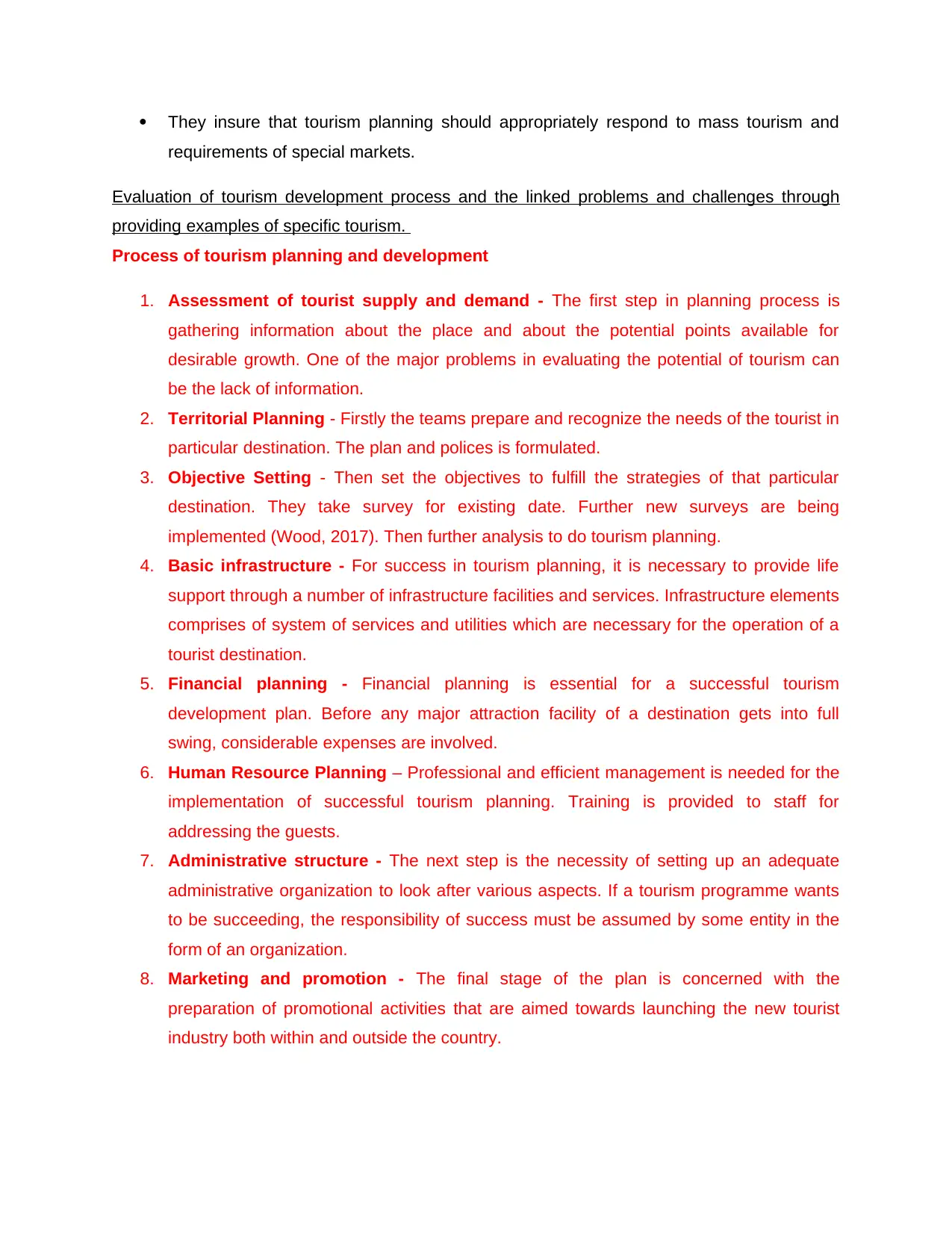
They insure that tourism planning should appropriately respond to mass tourism and
requirements of special markets.
Evaluation of tourism development process and the linked problems and challenges through
providing examples of specific tourism.
Process of tourism planning and development
1. Assessment of tourist supply and demand - The first step in planning process is
gathering information about the place and about the potential points available for
desirable growth. One of the major problems in evaluating the potential of tourism can
be the lack of information.
2. Territorial Planning - Firstly the teams prepare and recognize the needs of the tourist in
particular destination. The plan and polices is formulated.
3. Objective Setting - Then set the objectives to fulfill the strategies of that particular
destination. They take survey for existing date. Further new surveys are being
implemented (Wood, 2017). Then further analysis to do tourism planning.
4. Basic infrastructure - For success in tourism planning, it is necessary to provide life
support through a number of infrastructure facilities and services. Infrastructure elements
comprises of system of services and utilities which are necessary for the operation of a
tourist destination.
5. Financial planning - Financial planning is essential for a successful tourism
development plan. Before any major attraction facility of a destination gets into full
swing, considerable expenses are involved.
6. Human Resource Planning – Professional and efficient management is needed for the
implementation of successful tourism planning. Training is provided to staff for
addressing the guests.
7. Administrative structure - The next step is the necessity of setting up an adequate
administrative organization to look after various aspects. If a tourism programme wants
to be succeeding, the responsibility of success must be assumed by some entity in the
form of an organization.
8. Marketing and promotion - The final stage of the plan is concerned with the
preparation of promotional activities that are aimed towards launching the new tourist
industry both within and outside the country.
requirements of special markets.
Evaluation of tourism development process and the linked problems and challenges through
providing examples of specific tourism.
Process of tourism planning and development
1. Assessment of tourist supply and demand - The first step in planning process is
gathering information about the place and about the potential points available for
desirable growth. One of the major problems in evaluating the potential of tourism can
be the lack of information.
2. Territorial Planning - Firstly the teams prepare and recognize the needs of the tourist in
particular destination. The plan and polices is formulated.
3. Objective Setting - Then set the objectives to fulfill the strategies of that particular
destination. They take survey for existing date. Further new surveys are being
implemented (Wood, 2017). Then further analysis to do tourism planning.
4. Basic infrastructure - For success in tourism planning, it is necessary to provide life
support through a number of infrastructure facilities and services. Infrastructure elements
comprises of system of services and utilities which are necessary for the operation of a
tourist destination.
5. Financial planning - Financial planning is essential for a successful tourism
development plan. Before any major attraction facility of a destination gets into full
swing, considerable expenses are involved.
6. Human Resource Planning – Professional and efficient management is needed for the
implementation of successful tourism planning. Training is provided to staff for
addressing the guests.
7. Administrative structure - The next step is the necessity of setting up an adequate
administrative organization to look after various aspects. If a tourism programme wants
to be succeeding, the responsibility of success must be assumed by some entity in the
form of an organization.
8. Marketing and promotion - The final stage of the plan is concerned with the
preparation of promotional activities that are aimed towards launching the new tourist
industry both within and outside the country.
Paraphrase This Document
Need a fresh take? Get an instant paraphrase of this document with our AI Paraphraser
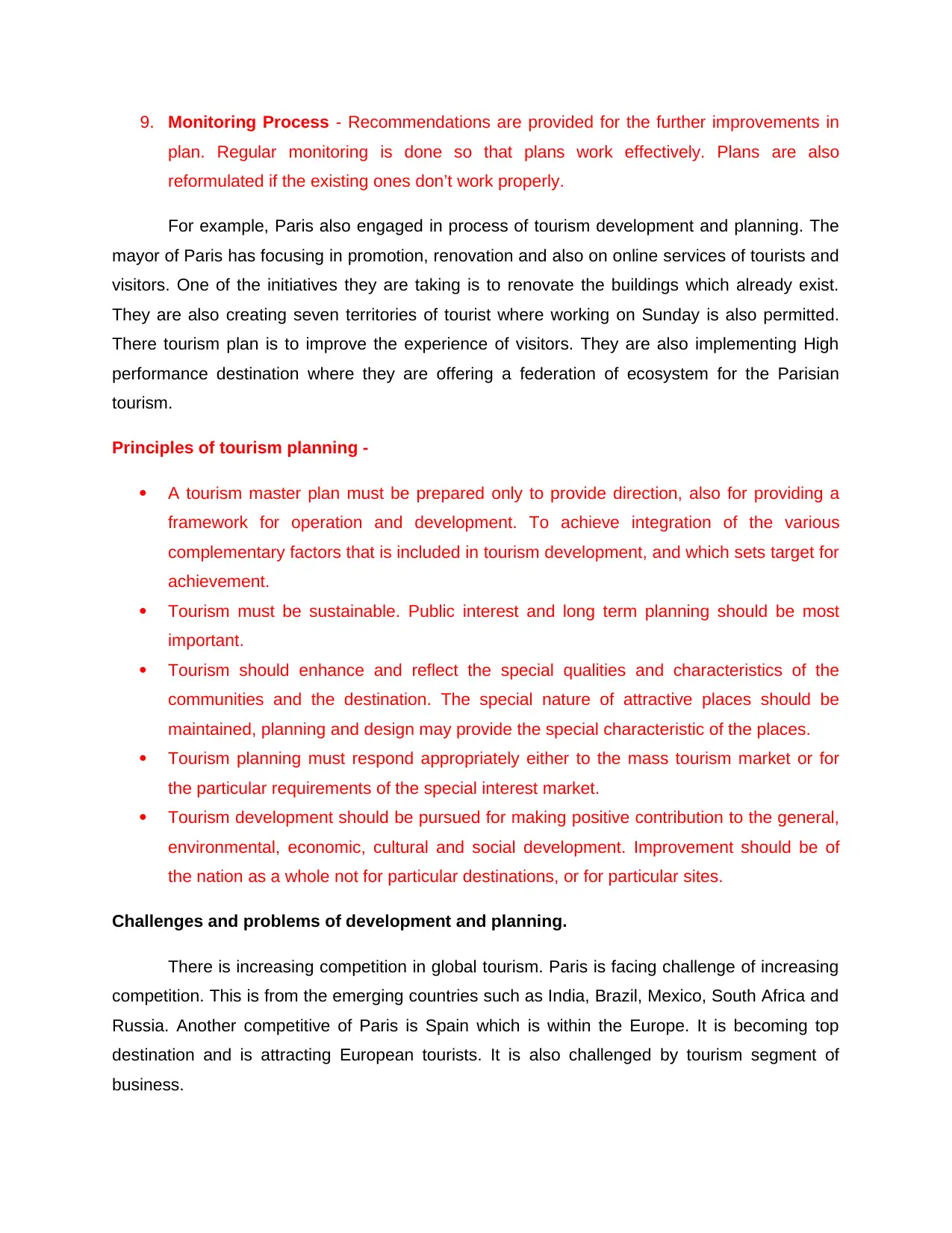
9. Monitoring Process - Recommendations are provided for the further improvements in
plan. Regular monitoring is done so that plans work effectively. Plans are also
reformulated if the existing ones don’t work properly.
For example, Paris also engaged in process of tourism development and planning. The
mayor of Paris has focusing in promotion, renovation and also on online services of tourists and
visitors. One of the initiatives they are taking is to renovate the buildings which already exist.
They are also creating seven territories of tourist where working on Sunday is also permitted.
There tourism plan is to improve the experience of visitors. They are also implementing High
performance destination where they are offering a federation of ecosystem for the Parisian
tourism.
Principles of tourism planning -
A tourism master plan must be prepared only to provide direction, also for providing a
framework for operation and development. To achieve integration of the various
complementary factors that is included in tourism development, and which sets target for
achievement.
Tourism must be sustainable. Public interest and long term planning should be most
important.
Tourism should enhance and reflect the special qualities and characteristics of the
communities and the destination. The special nature of attractive places should be
maintained, planning and design may provide the special characteristic of the places.
Tourism planning must respond appropriately either to the mass tourism market or for
the particular requirements of the special interest market.
Tourism development should be pursued for making positive contribution to the general,
environmental, economic, cultural and social development. Improvement should be of
the nation as a whole not for particular destinations, or for particular sites.
Challenges and problems of development and planning.
There is increasing competition in global tourism. Paris is facing challenge of increasing
competition. This is from the emerging countries such as India, Brazil, Mexico, South Africa and
Russia. Another competitive of Paris is Spain which is within the Europe. It is becoming top
destination and is attracting European tourists. It is also challenged by tourism segment of
business.
plan. Regular monitoring is done so that plans work effectively. Plans are also
reformulated if the existing ones don’t work properly.
For example, Paris also engaged in process of tourism development and planning. The
mayor of Paris has focusing in promotion, renovation and also on online services of tourists and
visitors. One of the initiatives they are taking is to renovate the buildings which already exist.
They are also creating seven territories of tourist where working on Sunday is also permitted.
There tourism plan is to improve the experience of visitors. They are also implementing High
performance destination where they are offering a federation of ecosystem for the Parisian
tourism.
Principles of tourism planning -
A tourism master plan must be prepared only to provide direction, also for providing a
framework for operation and development. To achieve integration of the various
complementary factors that is included in tourism development, and which sets target for
achievement.
Tourism must be sustainable. Public interest and long term planning should be most
important.
Tourism should enhance and reflect the special qualities and characteristics of the
communities and the destination. The special nature of attractive places should be
maintained, planning and design may provide the special characteristic of the places.
Tourism planning must respond appropriately either to the mass tourism market or for
the particular requirements of the special interest market.
Tourism development should be pursued for making positive contribution to the general,
environmental, economic, cultural and social development. Improvement should be of
the nation as a whole not for particular destinations, or for particular sites.
Challenges and problems of development and planning.
There is increasing competition in global tourism. Paris is facing challenge of increasing
competition. This is from the emerging countries such as India, Brazil, Mexico, South Africa and
Russia. Another competitive of Paris is Spain which is within the Europe. It is becoming top
destination and is attracting European tourists. It is also challenged by tourism segment of
business.
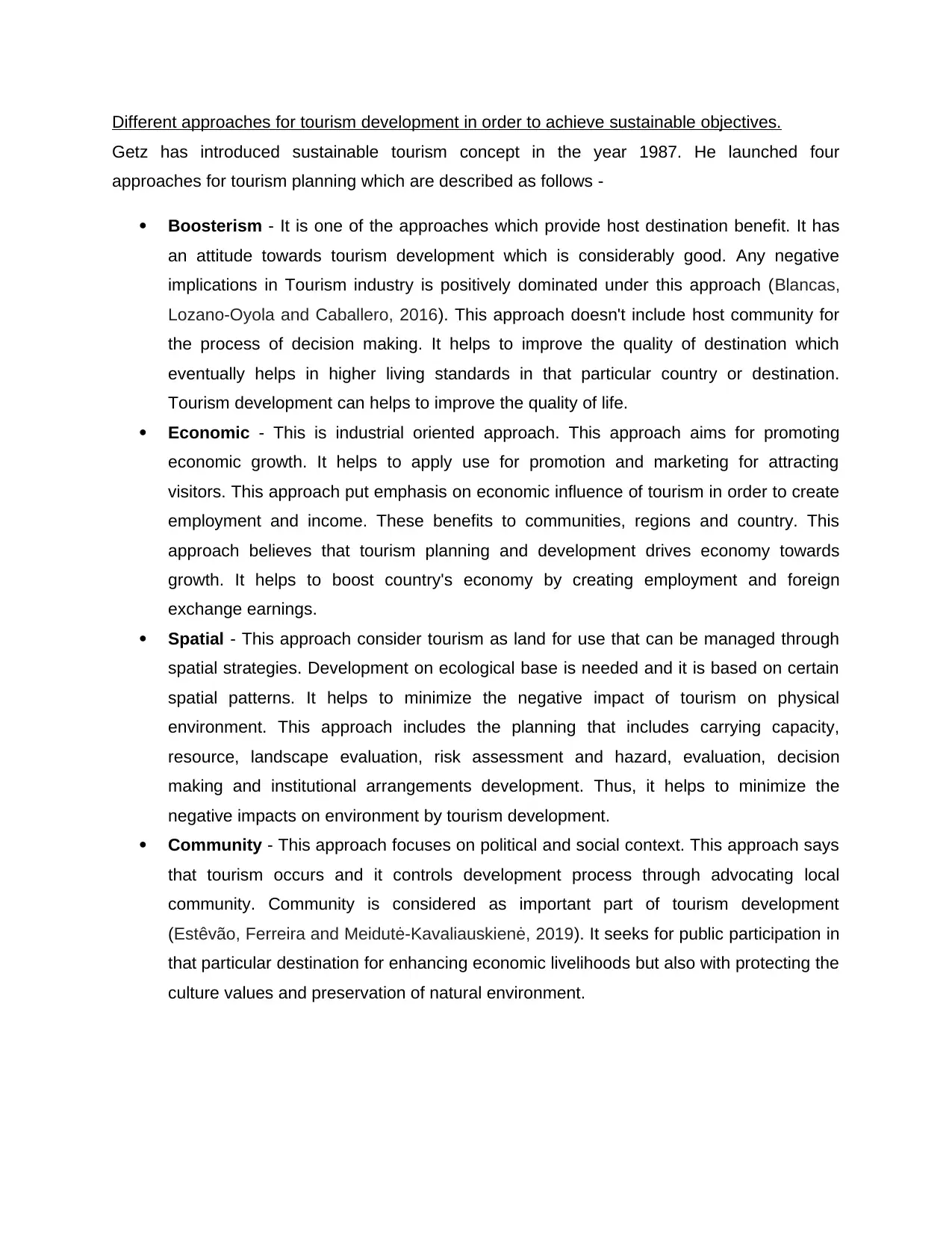
Different approaches for tourism development in order to achieve sustainable objectives.
Getz has introduced sustainable tourism concept in the year 1987. He launched four
approaches for tourism planning which are described as follows -
Boosterism - It is one of the approaches which provide host destination benefit. It has
an attitude towards tourism development which is considerably good. Any negative
implications in Tourism industry is positively dominated under this approach (Blancas,
Lozano-Oyola and Caballero, 2016). This approach doesn't include host community for
the process of decision making. It helps to improve the quality of destination which
eventually helps in higher living standards in that particular country or destination.
Tourism development can helps to improve the quality of life.
Economic - This is industrial oriented approach. This approach aims for promoting
economic growth. It helps to apply use for promotion and marketing for attracting
visitors. This approach put emphasis on economic influence of tourism in order to create
employment and income. These benefits to communities, regions and country. This
approach believes that tourism planning and development drives economy towards
growth. It helps to boost country's economy by creating employment and foreign
exchange earnings.
Spatial - This approach consider tourism as land for use that can be managed through
spatial strategies. Development on ecological base is needed and it is based on certain
spatial patterns. It helps to minimize the negative impact of tourism on physical
environment. This approach includes the planning that includes carrying capacity,
resource, landscape evaluation, risk assessment and hazard, evaluation, decision
making and institutional arrangements development. Thus, it helps to minimize the
negative impacts on environment by tourism development.
Community - This approach focuses on political and social context. This approach says
that tourism occurs and it controls development process through advocating local
community. Community is considered as important part of tourism development
(Estêvão, Ferreira and Meidutė-Kavaliauskienė, 2019). It seeks for public participation in
that particular destination for enhancing economic livelihoods but also with protecting the
culture values and preservation of natural environment.
Getz has introduced sustainable tourism concept in the year 1987. He launched four
approaches for tourism planning which are described as follows -
Boosterism - It is one of the approaches which provide host destination benefit. It has
an attitude towards tourism development which is considerably good. Any negative
implications in Tourism industry is positively dominated under this approach (Blancas,
Lozano-Oyola and Caballero, 2016). This approach doesn't include host community for
the process of decision making. It helps to improve the quality of destination which
eventually helps in higher living standards in that particular country or destination.
Tourism development can helps to improve the quality of life.
Economic - This is industrial oriented approach. This approach aims for promoting
economic growth. It helps to apply use for promotion and marketing for attracting
visitors. This approach put emphasis on economic influence of tourism in order to create
employment and income. These benefits to communities, regions and country. This
approach believes that tourism planning and development drives economy towards
growth. It helps to boost country's economy by creating employment and foreign
exchange earnings.
Spatial - This approach consider tourism as land for use that can be managed through
spatial strategies. Development on ecological base is needed and it is based on certain
spatial patterns. It helps to minimize the negative impact of tourism on physical
environment. This approach includes the planning that includes carrying capacity,
resource, landscape evaluation, risk assessment and hazard, evaluation, decision
making and institutional arrangements development. Thus, it helps to minimize the
negative impacts on environment by tourism development.
Community - This approach focuses on political and social context. This approach says
that tourism occurs and it controls development process through advocating local
community. Community is considered as important part of tourism development
(Estêvão, Ferreira and Meidutė-Kavaliauskienė, 2019). It seeks for public participation in
that particular destination for enhancing economic livelihoods but also with protecting the
culture values and preservation of natural environment.
⊘ This is a preview!⊘
Do you want full access?
Subscribe today to unlock all pages.

Trusted by 1+ million students worldwide
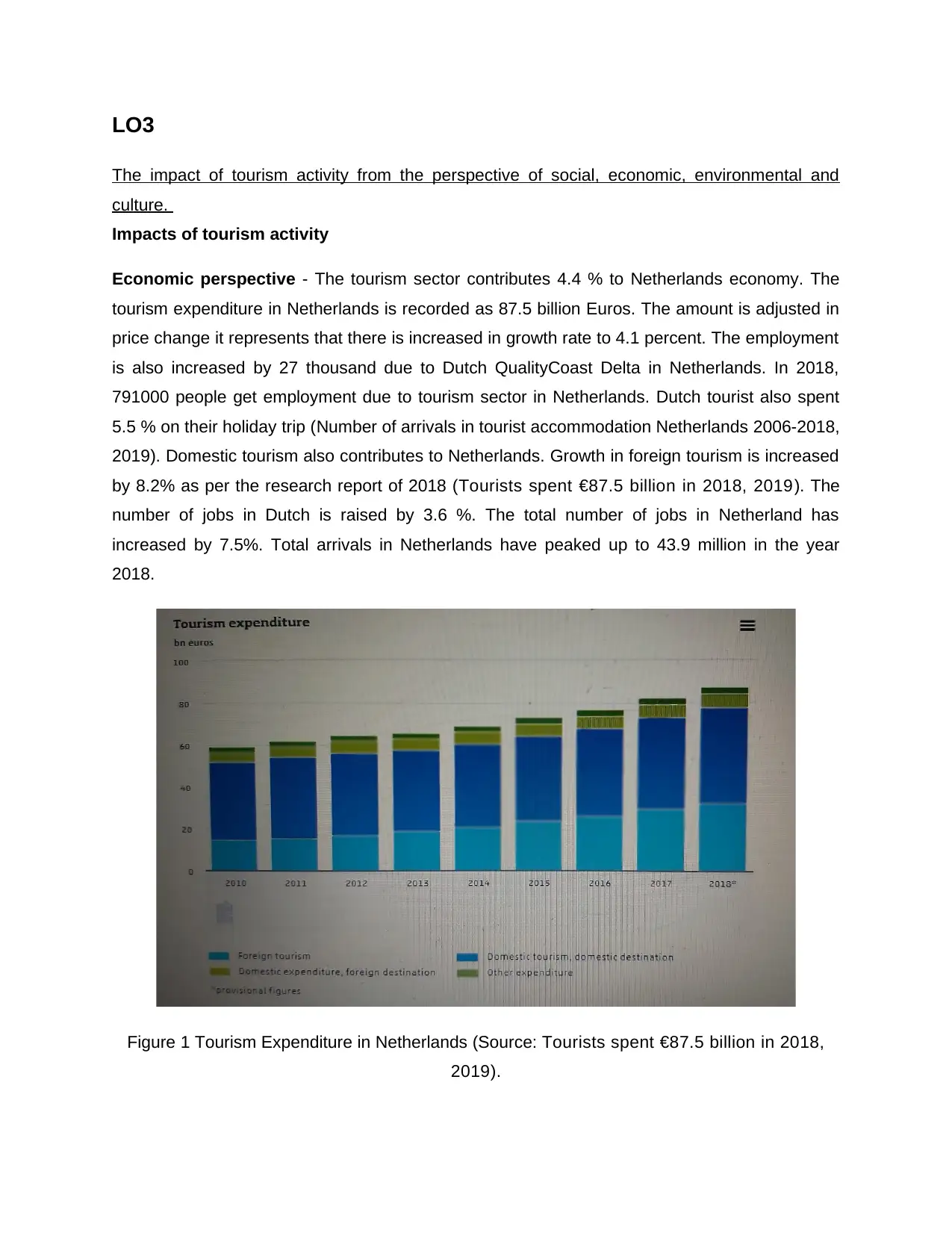
LO3
The impact of tourism activity from the perspective of social, economic, environmental and
culture.
Impacts of tourism activity
Economic perspective - The tourism sector contributes 4.4 % to Netherlands economy. The
tourism expenditure in Netherlands is recorded as 87.5 billion Euros. The amount is adjusted in
price change it represents that there is increased in growth rate to 4.1 percent. The employment
is also increased by 27 thousand due to Dutch QualityCoast Delta in Netherlands. In 2018,
791000 people get employment due to tourism sector in Netherlands. Dutch tourist also spent
5.5 % on their holiday trip (Number of arrivals in tourist accommodation Netherlands 2006-2018,
2019). Domestic tourism also contributes to Netherlands. Growth in foreign tourism is increased
by 8.2% as per the research report of 2018 (Tourists spent €87.5 billion in 2018, 2019). The
number of jobs in Dutch is raised by 3.6 %. The total number of jobs in Netherland has
increased by 7.5%. Total arrivals in Netherlands have peaked up to 43.9 million in the year
2018.
Figure 1 Tourism Expenditure in Netherlands (Source: Tourists spent €87.5 billion in 2018,
2019).
The impact of tourism activity from the perspective of social, economic, environmental and
culture.
Impacts of tourism activity
Economic perspective - The tourism sector contributes 4.4 % to Netherlands economy. The
tourism expenditure in Netherlands is recorded as 87.5 billion Euros. The amount is adjusted in
price change it represents that there is increased in growth rate to 4.1 percent. The employment
is also increased by 27 thousand due to Dutch QualityCoast Delta in Netherlands. In 2018,
791000 people get employment due to tourism sector in Netherlands. Dutch tourist also spent
5.5 % on their holiday trip (Number of arrivals in tourist accommodation Netherlands 2006-2018,
2019). Domestic tourism also contributes to Netherlands. Growth in foreign tourism is increased
by 8.2% as per the research report of 2018 (Tourists spent €87.5 billion in 2018, 2019). The
number of jobs in Dutch is raised by 3.6 %. The total number of jobs in Netherland has
increased by 7.5%. Total arrivals in Netherlands have peaked up to 43.9 million in the year
2018.
Figure 1 Tourism Expenditure in Netherlands (Source: Tourists spent €87.5 billion in 2018,
2019).
Paraphrase This Document
Need a fresh take? Get an instant paraphrase of this document with our AI Paraphraser
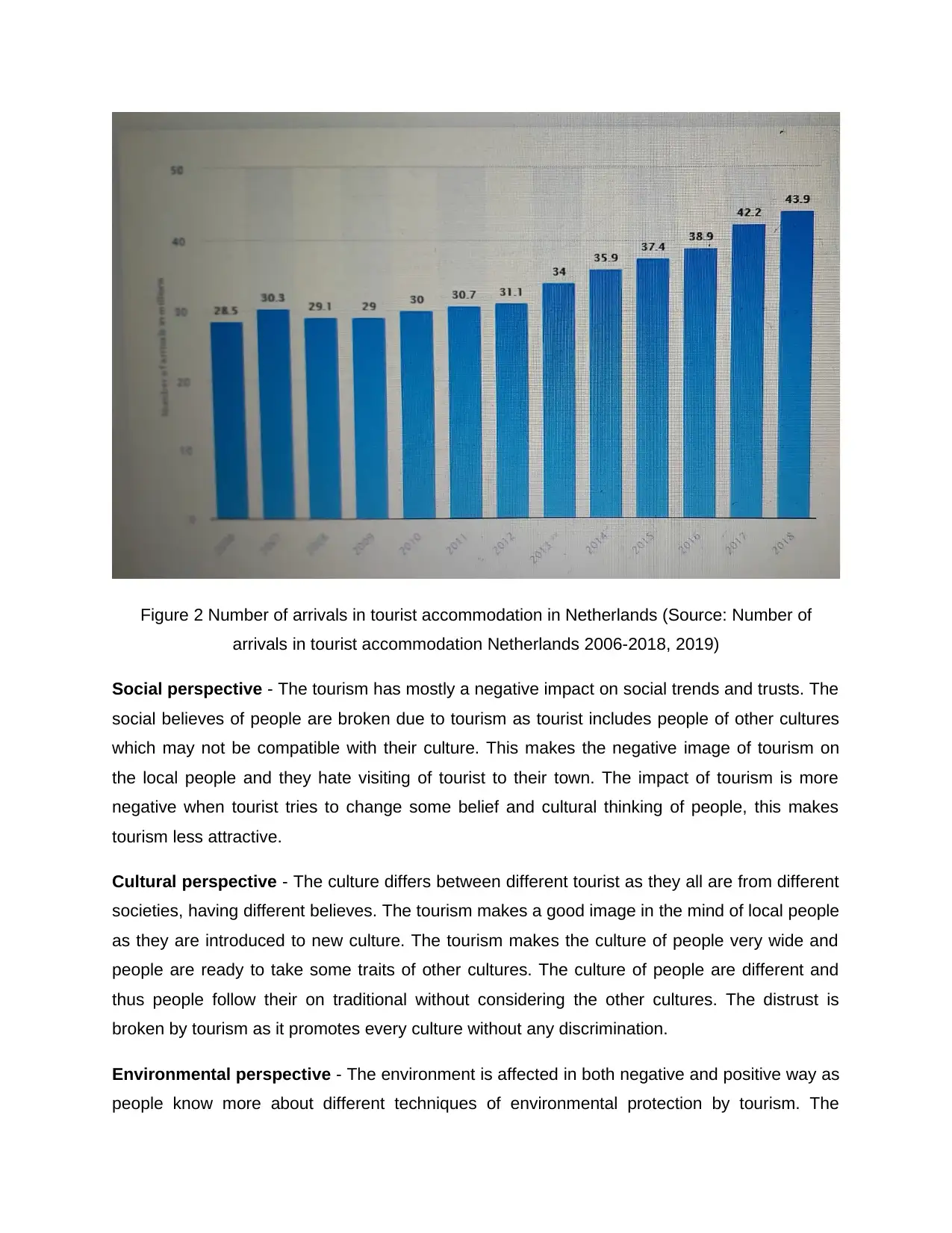
Figure 2 Number of arrivals in tourist accommodation in Netherlands (Source: Number of
arrivals in tourist accommodation Netherlands 2006-2018, 2019)
Social perspective - The tourism has mostly a negative impact on social trends and trusts. The
social believes of people are broken due to tourism as tourist includes people of other cultures
which may not be compatible with their culture. This makes the negative image of tourism on
the local people and they hate visiting of tourist to their town. The impact of tourism is more
negative when tourist tries to change some belief and cultural thinking of people, this makes
tourism less attractive.
Cultural perspective - The culture differs between different tourist as they all are from different
societies, having different believes. The tourism makes a good image in the mind of local people
as they are introduced to new culture. The tourism makes the culture of people very wide and
people are ready to take some traits of other cultures. The culture of people are different and
thus people follow their on traditional without considering the other cultures. The distrust is
broken by tourism as it promotes every culture without any discrimination.
Environmental perspective - The environment is affected in both negative and positive way as
people know more about different techniques of environmental protection by tourism. The
arrivals in tourist accommodation Netherlands 2006-2018, 2019)
Social perspective - The tourism has mostly a negative impact on social trends and trusts. The
social believes of people are broken due to tourism as tourist includes people of other cultures
which may not be compatible with their culture. This makes the negative image of tourism on
the local people and they hate visiting of tourist to their town. The impact of tourism is more
negative when tourist tries to change some belief and cultural thinking of people, this makes
tourism less attractive.
Cultural perspective - The culture differs between different tourist as they all are from different
societies, having different believes. The tourism makes a good image in the mind of local people
as they are introduced to new culture. The tourism makes the culture of people very wide and
people are ready to take some traits of other cultures. The culture of people are different and
thus people follow their on traditional without considering the other cultures. The distrust is
broken by tourism as it promotes every culture without any discrimination.
Environmental perspective - The environment is affected in both negative and positive way as
people know more about different techniques of environmental protection by tourism. The
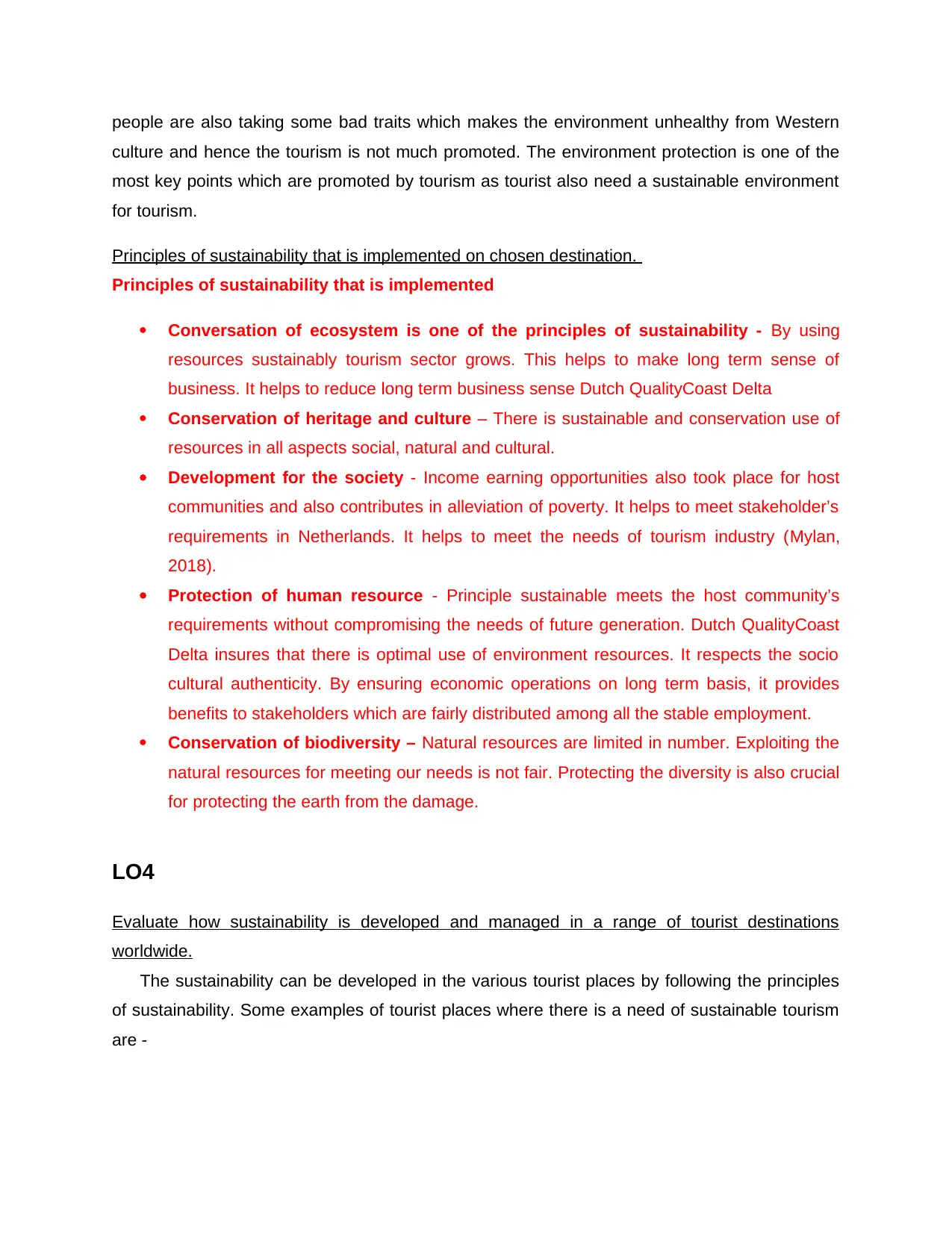
people are also taking some bad traits which makes the environment unhealthy from Western
culture and hence the tourism is not much promoted. The environment protection is one of the
most key points which are promoted by tourism as tourist also need a sustainable environment
for tourism.
Principles of sustainability that is implemented on chosen destination.
Principles of sustainability that is implemented
Conversation of ecosystem is one of the principles of sustainability - By using
resources sustainably tourism sector grows. This helps to make long term sense of
business. It helps to reduce long term business sense Dutch QualityCoast Delta
Conservation of heritage and culture – There is sustainable and conservation use of
resources in all aspects social, natural and cultural.
Development for the society - Income earning opportunities also took place for host
communities and also contributes in alleviation of poverty. It helps to meet stakeholder’s
requirements in Netherlands. It helps to meet the needs of tourism industry (Mylan,
2018).
Protection of human resource - Principle sustainable meets the host community’s
requirements without compromising the needs of future generation. Dutch QualityCoast
Delta insures that there is optimal use of environment resources. It respects the socio
cultural authenticity. By ensuring economic operations on long term basis, it provides
benefits to stakeholders which are fairly distributed among all the stable employment.
Conservation of biodiversity – Natural resources are limited in number. Exploiting the
natural resources for meeting our needs is not fair. Protecting the diversity is also crucial
for protecting the earth from the damage.
LO4
Evaluate how sustainability is developed and managed in a range of tourist destinations
worldwide.
The sustainability can be developed in the various tourist places by following the principles
of sustainability. Some examples of tourist places where there is a need of sustainable tourism
are -
culture and hence the tourism is not much promoted. The environment protection is one of the
most key points which are promoted by tourism as tourist also need a sustainable environment
for tourism.
Principles of sustainability that is implemented on chosen destination.
Principles of sustainability that is implemented
Conversation of ecosystem is one of the principles of sustainability - By using
resources sustainably tourism sector grows. This helps to make long term sense of
business. It helps to reduce long term business sense Dutch QualityCoast Delta
Conservation of heritage and culture – There is sustainable and conservation use of
resources in all aspects social, natural and cultural.
Development for the society - Income earning opportunities also took place for host
communities and also contributes in alleviation of poverty. It helps to meet stakeholder’s
requirements in Netherlands. It helps to meet the needs of tourism industry (Mylan,
2018).
Protection of human resource - Principle sustainable meets the host community’s
requirements without compromising the needs of future generation. Dutch QualityCoast
Delta insures that there is optimal use of environment resources. It respects the socio
cultural authenticity. By ensuring economic operations on long term basis, it provides
benefits to stakeholders which are fairly distributed among all the stable employment.
Conservation of biodiversity – Natural resources are limited in number. Exploiting the
natural resources for meeting our needs is not fair. Protecting the diversity is also crucial
for protecting the earth from the damage.
LO4
Evaluate how sustainability is developed and managed in a range of tourist destinations
worldwide.
The sustainability can be developed in the various tourist places by following the principles
of sustainability. Some examples of tourist places where there is a need of sustainable tourism
are -
⊘ This is a preview!⊘
Do you want full access?
Subscribe today to unlock all pages.

Trusted by 1+ million students worldwide
1 out of 17
Related Documents
Your All-in-One AI-Powered Toolkit for Academic Success.
+13062052269
info@desklib.com
Available 24*7 on WhatsApp / Email
![[object Object]](/_next/static/media/star-bottom.7253800d.svg)
Unlock your academic potential
Copyright © 2020–2025 A2Z Services. All Rights Reserved. Developed and managed by ZUCOL.



